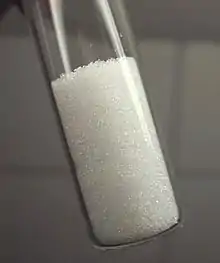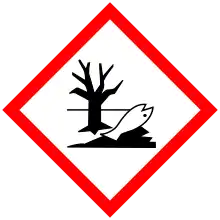Beryllium sulfate
Beryllium sulfate normally encountered as the tetrahydrate, [Be(H2O)4]SO4 is a white crystalline solid. It was first isolated in 1815 by Jons Jakob Berzelius.[4]
 | |
 | |
| Identifiers | |
|---|---|
| |
3D model (JSmol) |
|
| ChEBI | |
| ChemSpider | |
| ECHA InfoCard | 100.033.478 |
| EC Number |
|
PubChem CID |
|
| RTECS number |
|
| UNII |
|
CompTox Dashboard (EPA) |
|
| |
| |
| Properties[1] | |
| BeSO4 | |
| Molar mass | 105.075 g/mol (anhydrous) 177.136 g/mol (tetrahydrate) |
| Appearance | white solid |
| Odor | odorless |
| Density | 2.44 g/cm3 (anhydrous) 1.71 g/cm3 (tetrahydrate) |
| Melting point | 110 °C (230 °F; 383 K) (tetrahydrate, −2H2O) 400 °C (dihydrate, dehydr.) 550–600 decomposes |
| Boiling point | 2,500 °C (4,530 °F; 2,770 K) (anhydrate) 580 °C (tetrahydrate) |
| 36.2 g/100 mL (0 °C) 40.0 g/100 mL (20 °C) 54.3 g/100 mL (60 °C) | |
| Solubility | insoluble in alcohol |
Refractive index (nD) |
1.4374 (tetrahydrate) |
| Thermochemistry | |
Std molar entropy (S |
90 J/mol K |
Std enthalpy of formation (ΔfH⦵298) |
-1197 kJ/mol |
Gibbs free energy (ΔfG˚) |
-1088 kJ/mol |
| Hazards | |
| Safety data sheet | ICSC 1351 |
| GHS pictograms |    |
| GHS Signal word | Danger |
| H350, H330, H301, H372, H319, H335, H315, H317, H411 | |
| Flash point | Non-flammable |
| Lethal dose or concentration (LD, LC): | |
LD50 (median dose) |
82 mg/kg (rat, oral) 80 mg/kg (mouse, oral)[2] |
| NIOSH (US health exposure limits): | |
PEL (Permissible) |
TWA 0.002 mg/m3 C 0.005 mg/m3 (30 minutes), with a maximum peak of 0.025 mg/m3 (as Be)[3] |
REL (Recommended) |
Ca C 0.0005 mg/m3 (as Be)[3] |
IDLH (Immediate danger) |
Ca [4 mg/m3 (as Be)][3] |
| Related compounds | |
Other cations |
Magnesium sulfate Calcium sulfate Strontium sulfate Barium sulfate |
Except where otherwise noted, data are given for materials in their standard state (at 25 °C [77 °F], 100 kPa). | |
| Infobox references | |
Beryllium sulfate may be prepared by treating an aqueous solution of any beryllium salt with sulfuric acid, followed by evaporation of the solution and crystallization. The hydrated product may be converted to anhydrous salt by heating at 400 °C.[5] The tetrahydrate contains a tetrahedral Be(OH2)42+ unit and sulfate anions. The small size of the Be2+ cation determines the number of water molecules that can be coordinated. This contrasts with the analogous magnesium salt, MgSO4·6H2O which contains an octahedral Mg(OH2)62+ unit.[6]
The anhydrous compound has a structure similar to that of berlinite. The structure contains alternating tetrahedrally coordinated Be and S and each oxygen is 2 coordinate (Be-O-S). The Be-O distance is 156 pm and the S-O distance is 150 pm.[7]
A mixture of beryllium and radium sulfate was used as the neutron source in the discovery of nuclear fission.
References
- Weast, Robert C., ed. (1981). CRC Handbook of Chemistry and Physics (62nd ed.). Boca Raton, FL: CRC Press. p. B-82. ISBN 0-8493-0462-8..
- "Beryllium compounds (as Be)". Immediately Dangerous to Life and Health Concentrations (IDLH). National Institute for Occupational Safety and Health (NIOSH).
- NIOSH Pocket Guide to Chemical Hazards. "#0054". National Institute for Occupational Safety and Health (NIOSH).
- Lathrop Parsons, Charles (1909), The Chemistry and Literature of Beryllium, London, pp. 29–33, ISBN 9780559264160.
- Patnaik, Pradyot (2002), Handbook of Inorganic Chemicals, McGraw-Hill, ISBN 0-07-049439-8.
- Wells A.F. (1984) Structural Inorganic Chemistry 5th edition Oxford Science Publications ISBN 0-19-855370-6
- Grund, Alfred (1955). "Die Kristallstruktur von BeSO4". Tschermaks Mineralogische und Petrographische Mitteilungen. 5 (3): 227–230. Bibcode:1955MinPe...5..227G. doi:10.1007/BF01191066. ISSN 0041-3763.
External links
- International Chemical Safety Card 1351
- IARC Monograph "Beryllium and Beryllium Compounds"
- IPCS Health & Safety Guide 44
- IPCS Environmental Health Criteria 106: Beryllium
- IPCS CICAD 32